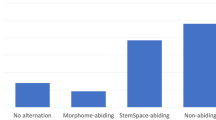Abstract
Evidence from Italian conjugation shows that the structure of a verbparadigm can be characterised formally in terms of a distribution of slotsinto a number of equivalence classes, or set partition, where each equivalenceclass is associated with a distinct Aronovian basic stem type. A few set partitionsaccount for the structure of all Italian verb paradigms, whether regular orless regular. This well-behaved family of distributions tightly constrainsstem allomorphy at an appropriate level of abstraction, independently of whetherthe origin of allomorphy is morpho-phonological or purely morphological, showingthe superiority of the obtained generalisations over syntagmatic accounts.In the paper, we illustrate some formal properties of the discovered partitions,and emphasise interesting connections with morphological productivity, historicalchange and language learning.
Similar content being viewed by others
References
Andersen, H. 1972. Abductive and deductive change. In: Language 49: 765–93.
Aronoff, M. 1994. Morphology by itself. MIT Press, Cambridge MA.
Beard, R. 1995. Lexeme-morpheme base morphology: a general theory of inflection and word formation. State University of New York Press, Albany.
Bybee, J. 1988. Morphology as lexical organization. In: Hammond, M.-Noonan, N. (eds): Theoretical morphology. Approaches in modern linguistics, 119–41. Academic Press, San Diego.
Bybee, J. 1996. Productivity, regularity and fusion: how language use affects the lexicon. In: Singh, R. (ed.): Trubetzkoy's orphan: proceedings of the Montreal roundtable-Morphonology: contemporary responses-, Current Issues in Linguistic Theory, 144, 247–79. John Benjamins, Amsterdam and Philadelphia.
Carstairs, A. 1990. Phonologically conditioned suppletion. In: Dressler, W.U.-Luschützky, H.C.-Pfeiffer, O.E.-Rennison, J.R. (eds): Contemporary morphology, 17–23. de Gruyter, Berlin.
Daelemans, W. 1996. Abstraction considered harmful: lazy learning of language processing. In: van den Herik, H.-Weijters, A. (eds): Proceedings of the 6th Belgian-Dutch Conference on Machine Learning, 3–12. Maastricht.
Dressler, W.U. 1987. Word formation as part of natural morphology. In: Dressler, W.-Mayerthaler, W.-Panagl, O.-Wurzel, W. (eds): Leitmotifs in Natural Morphology, 99–124. John Benjamins, Amsterdam and Philadelphia.
Federici, S.-Pirrelli, V.-Yvon, F. 1996. A dynamic approach to paradigm-driven analogy. In: Wermter, S.-Riloff, E.-Scheler, G. (eds): Symbolic, connectionist and statistical approaches to natural language processing, 385–98. Springer-Verlag, Berlin.
Harris, J.W. 1973. On the order of certain phonological rules in Spanish. In: Anderson, S.-Kiparsky, P. (eds): A Festschrift for Morris Halle, 59–76. Holt, Rinehart and Winston, New York.
Hudson, G. 1974. The representation of non-productive alternation. In: Anderson, J.-Jones, C. (eds): Historical linguistics, 203–29. North Holland, Amsterdam.
Hudson, R. 1984. Word grammar. Blackwell, Oxford and Cambridge MA.
Kiparsky, P. 1982. Explanation in phonology. Foris, Dordrecht.
Kiparsky, P. 1996. Allomorphy and morphophonology. In: Singh, R. (ed.): Trubetzkoy's orphan: proceedings of the Montreal roundtable-Morphonology: contemporary responses-, Current Issues in Linguistic Theory, 144, 13–63. John Benjamins, Amsterdam and Philadelphia.
Lepage, Y. 1998. Solving analogies of words: an algorithm. In: Proceedings of COLING-ACL '98, 728–35. Montreal.
Lepage, Y.-Shin-Ici, A. 1996. Saussurean analogy: a theoretical account and its application. In: Proceedings of COLING-96, 717–22. Copenhagen.
Lieber, R. 1981. On the organization of the lexicon. Indiana University Linguistic Club, Bloomington.
Lightner, T. 1968. On the use of minor rules in Russian phonology. In: Journal of Linguistics 4: 69–72.
Matthews, P.H. 1972. Inflectional morphology. A theoretical study based on aspects of Latin verb conjugation. Cambridge University Press, Cambridge.
Matthews, P.H. 1981. Present stem alternation in Italian. In: Geckeler, H.-Schlieben-Lange, B.-Trabant, J.-Weydt, H. (eds): Logos semanticos: studia linguistica in honorem Eugenio Coseriu, 57–65. de Gruyter, Berlin.
Matthews, P.H. 1991. Morphology (Second edition). Cambridge University Press, Cambridge.
Mitchell, T. 1997. Machine learning. McGraw-Hill, Boston MA.
Pike, K.L. 1963. Theoretical implications of matrix permutation in Fore (New Guinea). In: Anthropological Linguistics 5.
Pirrelli, V.-Battista, M. 1998. The paradigmatic dimension of stem allomorphy in Italian inflection, ILC-CNR Technical Report. Pisa, Italy.
Pirrelli, V.-Federici, S. 1993. An analogical way to language modelling: MORPHEUS. Acta Linguistica Hungarica 41: 235–63.
Pirrelli, V.-Federici, S. 1994. 'Derivational' paradigms in morphonology. In:Proceedings of COLING-94, Kyoto.
Pirrelli, V.-Yvon, F. 1998. Analogy in the lexicon: a probe into analogy-based machine learning of language. In: Proceedings of the 6th International Symposium on Human Communication, 576–81. Santiago de Cuba.
Pirrelli, V.-Yvon, F. 1999. The hidden dimension: a paradigmatic view of data-driven NLP. In: Journal of Experimental and Theoretical Artificial Intellinece 11: 391–408.
Rohlfs, G. 1966. Grammatica Storica della Lingua Italiana e dei suoi Dialetti. Einaudi, Torino.
Scalise, S. 1981. Il suffisso Xione e alcune ipotesi della morfologia lessicale. In: Rivista di Grammatica Generativa 6: 155–79.
Scalise, S. 1983. Morfologia lessicale. CLESP, Padua.
Skousen, R. 1989. Arguments for modeling of language. Kluwer, Dordrecht.
Spencer, A. 1988. Arguments for morpholexical rules. In: Linguistics 24: 1–29.
Stump, G.T. 1995. Stem formation, stem indexing, and stem choice. Ms.
Wanner, D. 1972. The derivation of inflectional paradigms in Italian. In: Casagrande, J.-Saciuk, B. (eds): Generative studies in Romance languages, 293–318. Newbury House, Rowly MA.
Zwicky, A. 1990. Inflectional morphology as a (sub)component of grammar. In: Dressler, W.U.-Luschützky, H.C.-Pfeiffer, O.E.-Rennison, J.R. (eds): Contemporary morphology, 217–36. de Gruyter, Berlin.
Author information
Authors and Affiliations
Rights and permissions
About this article
Cite this article
Pirrelli, V., Battista, M. On the interaction of paradigmatic and syntagmatic stem alternation in Italian conjugation. Acta Linguistica Hungarica 47, 289–314 (2000). https://doi.org/10.1023/A:1014022800781
Issue Date:
DOI: https://doi.org/10.1023/A:1014022800781




